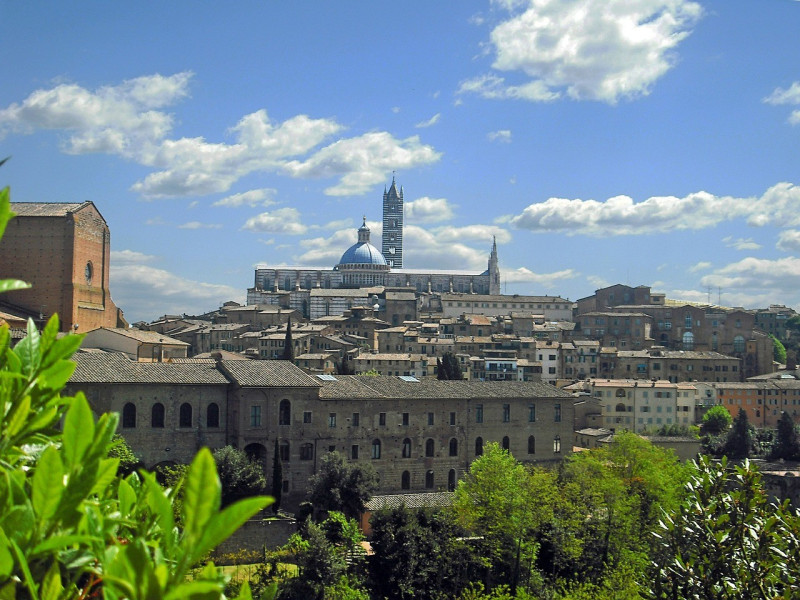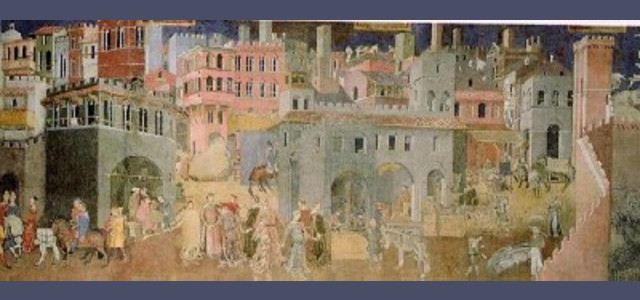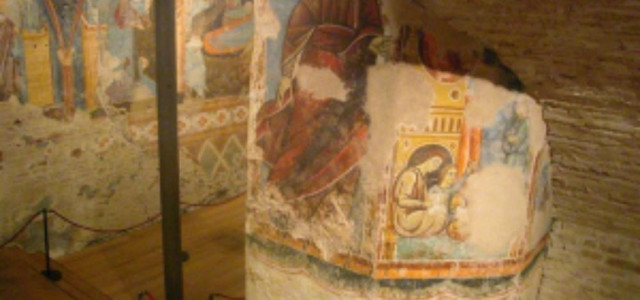Siena
Siena (Italian pronunciation: [ˈsjɛːna] ( ); in English sometimes spelled Sienna) is a city in Tuscany, Italy. It is the capital of the province of Siena. The historic centre of Siena has been declared by UNESCO a World Heritage Site. It is one of the nation's most visited tourist attractions, with over 163,000 international arrivals in 2008. Siena is famous for its cuisine, art, museums, medieval cityscape and the Palio, a horse race held twice a year. History Siena, like other Tuscan hill towns, was first settled in the time of the Etruscans (c. 900–400 BC) when it was inhabited by a tribe called the Saina. The Etruscans were an advanced people who changed the face of central Italy through their use of irrigation to reclaim previously unfarmable land, and their custom of building their settlements in well-defended hill forts. A Roman town called Saena Julia was founded at the site in the time of the Emperor Augustus. The first document mentioning it dates from AD 70. Some archaeologist assert that Siena was controlled for a period by a Gaulish tribe called the Senones. The Roman origin accounts for the town's emblem, a she-wolf suckling the infants Romulus and Remus. According to legend, Siena was founded by Senius and Aschius, the two sons of Remus, who was in turn the brother of Romulus, after whom Rome was named. Statues and other artwork depicting a she-wolf suckling the young twins Romulus and Remus can be seen all over the city of Siena. Other etymologies derive the name from the Etruscan family name Saina, the Roman family name Saenii, or the Latin word senex "old" or its derived form seneo "to be old". Siena did not prosper under Roman rule. It was not sited near any major roads and lacked opportunities for trade. Its insular status meant that Christianity did not penetrate until the 4th century AD, and it was not until the Lombards invaded Siena and the surrounding territory that it knew prosperity. After the Lombard occupation, the old Roman roads of Via Aurelia and the Via Cassia passed through areas exposed to Byzantine raids, so the Lombards rerouted much of their trade between the Lombards' northern possessions and Rome along a more secure road through Siena. Siena prospered as a trading post, and the constant streams of pilgrims passing to and from Rome provided a valuable source of income in the centuries to come. The oldest aristocratic families in Siena date their line to the Lombards' surrender in 774 to Charlemagne. At this point, the city was inundated with a swarm of Frankish overseers who married into the existing Sienese nobility and left a legacy that can be seen in the abbeys they founded throughout Sienese territory. Feudal power waned however, and by the death of Countess Matilda in 1115 the border territory of the Mark of Tuscia which had been under the control of her family, the Canossa, broke up into several autonomous regions. This ultimately resulted into the creation of the Republic of Siena. It existed for over four hundred years, from the late 11th century until the year 1555. During the golden age of Siena before the Black death in 1348, the city was home to 50,000 people. In the Italian War of 1551–1559, the republic was defeated by the rival Duchy of Florence in alliance with the Spanish crown. After 18 months of resistance, Siena surrendered to Spain on 17 April 1555, marking the end of the republic. The new Spanish King Philip, owing huge sums to the Medici, ceded it (apart a series of coastal fortress annexed to the State of Presidi) to the Grand Duchy of Tuscany, to which it belonged until the unification of Italy in the 19th century. A Republican government of 700 Sienese families in Montalcino resisted until 1559. The picturesque city remains an important cultural centre, especially for humanist disciplines. Main sights The Siena Cathedral (Duomo), begun in the 12th century, is one of the great examples of Italian Romanesque-Gothic architecture. Its main façade was completed in 1380. It is unusual for a cathedral in that its axis runs north-south. This is because it was originally intended to be the largest cathedral in the world, with a north-south transept and an east-west nave. After the completion of the transept and the building of the east wall (which still exists and may be climbed by the public via an internal staircase) the money ran out and the rest of the cathedral was abandoned. Inside is the famous Gothic octagonal pulpit by Nicola Pisano (1266–1268) supported on lions, and the labyrinth inlaid in the flooring, traversed by penitents on their knees. Within the Sacristy are some perfectly preserved renaissance frescos by Domenico Ghirlandaio, and, beneath the Duomo, in the baptistry is the baptismal font with bas-reliefs by Donatello, Lorenzo Ghiberti, Jacopo della Quercia and other 15th-century sculptors. The Museo dell'Opera del Duomo contains Duccio's famous Maestà (1308–1311) and various other works by Sienese masters. More Sienese paintings are to be found in the Pinacoteca, e.g. 13th-century works by Dietisalvi di Speme. The shell-shaped Piazza del Campo, the town square, which houses the Palazzo Pubblico and the Torre del Mangia, is another architectural treasure, and is famous for hosting the Palio horse race. The Palazzo Pubblico, itself a great work of architecture, houses yet another important art museum. Included within the museum is Ambrogio Lorenzetti's series of frescos Allegoria ed effetti del Bouno e Cattivio Governo (The Allegory and Effects of Good and Bad Government) and also some of the finest frescoes of Simone Martini and Pietro Lorenzetti. On the Piazza Salimbeni is the Palazzo Salimbeni, a notable building and also the medieval headquarters of Monte dei Paschi di Siena, one of the oldest banks in continuous existence and a major player in the Sienese economy. Housed in the notable Gothic Palazzo Chigi on Via di Città is the Accademia Musicale Chigiana, Siena's conservatory of music. Other churches in the city include: Basilica dell'Osservanza Santa Maria dei Servi San Domenico San Francesco Santo Spirito San Martino Sanctuary of Santa Caterina, incorporating the old house of St. Catherine of Siena. It houses the miraculous Crucifix (late 12th century) from which the saint received her stigmata, and a 15th-century statue of St. Catherine. The historic Siena synagogue is also preserved and open to visitors. The city's gardens include the Orto Botanico dell'Università di Siena, a botanical garden maintained by the University of Siena. The Medicean Fortress houses the Enoteca Italiana and the Siena Jazz School, with courses and concerts throughout the year, and a festival during the International Siena Jazz Masterclasses. In the neighbourhood are numerous patrician villa, numerous of which attributed to Baldassarre Peruzzi: Villa Chigi Castle of Belcaro Villa Celsa Villa Cetinale Villa Volte Alte Culture Contrade Siena retains a ward-centric culture from medieval times. Each ward (contrada) is represented by an animal or mascot, and has its own boundary and distinct identity. Ward rivalries are most rampant during the annual horse race (Palio) in the Piazza del Campo. The Palio The Palio di Siena is a traditional medieval horse race run around the Piazza del Campo twice each year, on 2 July and 16 August. The event is attended by large crowds, and is widely televised. Seventeen Contrade (which are city neighbourhoods originally formed as battalions for the city's defence) vie for the trophy: a painted banner, or Palio bearing an image of the Blessed Virgin Mary. For each race a new Palio is commissioned by well-known artists and Palios won over many years can often be seen in the local Contrade museum. During each Palio period, the city is decked out in lamps and flags bearing the Contrade colours. Ten of the seventeen Contrade run in each Palio: seven run by right (having not run in the previous year's corresponding Palio) together with three drawn by lot from the remaining ten. A horse is assigned to each by lot and is then guarded and cared for in the Contrade stable. The jockeys are paid huge sums and indeed there are often deals and bribes between jockeys or between "allied" Contrade committees to hinder other riders, especially those of 'enemy' Contrade. For the three days preceding the Palio itself, there are practice races. The horses are led from their stables through the city streets to the Campo, accompanied by crowds wearing Contrade scarves or tee-shirts and the air is filled with much singing and shouting. Though often a brutal and dangerous competition for horse and bare-back rider alike, the city thrives on the pride this competition brings. The Palio is not simply a tourist event as a true Sienese regards this in an almost tribal way, with passions and rivalry similar to that found at a football 'Derby' match. In fact the Sienese are baptised twice, once in church and a second time in their own Contrade fountain. This loyalty is maintained through a Contrade 'social club' and regular events and charitable works. Indeed the night before the Palio the city is a mass of closed roads as each Contrade organises its own outdoor banquet, often for numbers in excess of 1,000 diners. On the day of the Palio itself the horses are accompanied by a spectacular display of drummers and flag twirlers dressed in traditional medieval costumes who first lead the horse and jockey to the Contrade parish church and then join a procession around the Piazza del Campo square. This traditional parade is called the Corteo Storico, which begins in the streets and concludes in the Piazza del Campo encircling the square. There are often long delays while the race marshall attempts to line up the horses, but once underway the Campo becomes a cauldron of wild emotion for the 3 minutes of the race. This event is not without its controversy however, and recently, there have been complaints about the treatment of the horses and to the danger run by the riders. To better protect the horses, steps have been taken to make veterinary care more easily available during the main race. Also at the most dangerous corners of the course, cushions are used to help protect both the riders and horses. Art Over the centuries, Siena has had a rich tradition of arts and artists. The list of artists from the Sienese School include Duccio and his student Simone Martini, Pietro Lorenzetti and Martino di Bartolomeo. A number of well known works of Renaissance and High Renaissance art still remain in galleries or churches in Siena. The Church of San Domenico contains art by Guido da Siena, dating to mid-13th century. Duccio's Maestà which was commissioned by the City of Siena in 1308 was instrumental in leading Italian painting away from the hieratic representations of Byzantine art and directing it towards more direct presentations of reality. And his Madonna and Child with Saints polyptych, painted between 1311 and 1318 remains at the city's Pinacoteca Nazionale. The Pinacoteca also includes several works by Domenico Beccafumi, as well as art by Lorenzo Lotto, Domenico di Bartolo and Fra Bartolomeo. Economy The main activities are tourism, services, agriculture, handicrafts and light industry. Agriculture Agriculture constitutes Siena's primary industry. As of 2009, Siena's agricultural workforce comprises 919 companies with a total area of 10.755 square kilometres (4.153 sq mi) for a UAA (usable agricultural area) of 6.954 square kilometres (2.685 sq mi) or about 1/30 of the total municipal area (data ISTAT for the 2000 Agriculture Census V). Industry and manufacturing The industrial sector of the Sienese economy is not very developed. However, the area has seen recent growth in important core manufacturing enterprises. The confectionery industry is one of the most important of the traditional sectors of the secondary industry, because of the many local specialties. Among the best known are Panforte, a precursor to modern fruitcake, Ricciarelli biscuits, made out of almond paste, and the well-known gingerbread, and thehorses. Also renowned is "Noto" a sweet made of honey, almonds and pepper. The area known for making these delicacies ranges between Tuscany and Umbria. Other seasonal specialties are the chestnut and the pan de 'Santi (or Pan co' Santi) traditionally prepared in the weeks preceding the Festival of Saints, the November 1. All are marketed both industrial and artisan bakeries in different cities. The area has also seen a growth in biotechnology. Centenary Institute Sieroterapico Achille Sclavo, is now Swiss-owned and operates under the company name, Novartis Vaccines. Novartis develops and produces vaccines and employs about a thousand people. Service industry, financial and light commerce In this area, the most important financial activities are those related to the bank Monte dei Paschi di Siena. The oldest bank still in existence, headquartered in Siena, Italy, which has been operating continuously since 1472. There are also important appearances of the university and the hospital, which employ thousands of people and serves a catchment area much wider than the already large territory province. In the territory there is a dense network of micro-enterprises (less than 10,000) active in trade and tourism. In the last ten years, Siena has been completely wired with fibre optic cable. This distinction makes Siena the first city in Italy to complete Telecom's Socrates Project (Progetto Socrate). As a result, the town can claim that almost every house is wired for cable. The wiring, built by private companies in partnership with the city, helped to create a civic public station (Channel Civic Sienese) cable that transmits information and local news and gives access to Internet broadband. In 2007, however, the station was privatised, separating the TV from the Internet. The wiring is currently extending to major centres of the province through another company set up ad hoc (earth cable). Research and development The last few years have seen increased attention to biotechnology and research. As a consequence, local banking enterprises have focused on developing funding and supporting research and "startup" enterprises. Sports Siena has enjoyed a long tradition in sports. Basketball and football are perhaps the most popular in Siena, but other sports such as rugby and Athletics are also practised. Professional sports Associazione Calcio Siena (football) was founded in 1904 and fully established in 1908. It was first promoted to Italy's top league, Serie A, for the 2003–04 season. Currently it is in Serie B. The club hosts its games at the Stadio Artemio Franchi. The premier society of men's basketball in Siena is called Mens Sana Basket (also referred to by its sponsored name of Montepaschi Siena). It is also the oldest sports society in Siena. Mens Sana Basket participates in the highest level of play in Italy, Lega Basket Serie A, and it has won the national championship eight times, with a current streak of seven (2004 and 2007–2013). The team host their home games at PalaEstra indoor arena. Amateur sports As with most of Italy, football is very popular, and numerous amateur football teams have been formed. Tournaments for amateur football leagues are carried out during the winter. Siena is home to several amateur basketball teams: these include the Associazione Sportiva Costone Basket and Virtus Siena. There exist several female university sports teams organised under the CUS (Centro Universitario Sportivo.) These include such sports as fencing, volleyball and rugby. Transport The nearest international airports to Siena are Peretola Airport in Florence and Galileo Galilei International Airport in Pisa. There are two to three buses daily (Sena line) between Siena and Bologna Airport as well. Siena can be reached by train from both Pisa and Florence, changing at Empoli. Siena railway station is located at the bottom of a long hill outside the city walls, and travellers with luggage should look for a taxi or bus (from the stop opposite the station). Buses leave from Piazza Gramsci, located within the city walls. Buses are available directly to and from Florence, a one hour trip, as well as from Rome (three hours), Milan (four and a half hours), and from various other towns in Tuscany and beyond. By road, Siena is linked to Florence by a "superstrada" (the Raccordo Autostradale RA03 – Siena-Firenze), a form of toll free autostrada. The superstrada to Florence is indicated on some road signs with the letters SI-FI, referring to province abbreviations. A continuation of the same four lane road to the south east will facilitate the drive towards Perugia and to Rome trought A1 highway. Almost no automobile traffic is permitted within the city centre. Several large car parks are located immediately outside the city walls. The "La Fortezza" and "Il Campo" car parks are closest to the centre; free lots are further out (near Porta Romana). Commercial traffic is permitted within the city only during morning hours. Twin towns Siena is twinned with: Avignon, France Weimar, Germany, since 1994 Wetzlar, Germany, since 1987 Climate Climate is characterized by relatively high temperatures and evenly distributed precipitation. The Köppen Climate Classification subtype for this climate is "Cfa" (Humid Subtropical Climate). Gallery References Sources A Medieval Italian Commune: Siena under the Nine, 1287–1355 by Professor William M. Bowsky (1982) McIntyre, Anthony Osler. Medieval Tuscany and Umbria (1992) ISBN 0-670-83525-0 Nevola, Fabrizio (2007). Siena: Constructing the Renaissance city (second ed.). Yale University Press. ISBN 978-0-300-12678-5. Retrieved 1 March 2010. External links Siena travel guide from Wikivoyage






